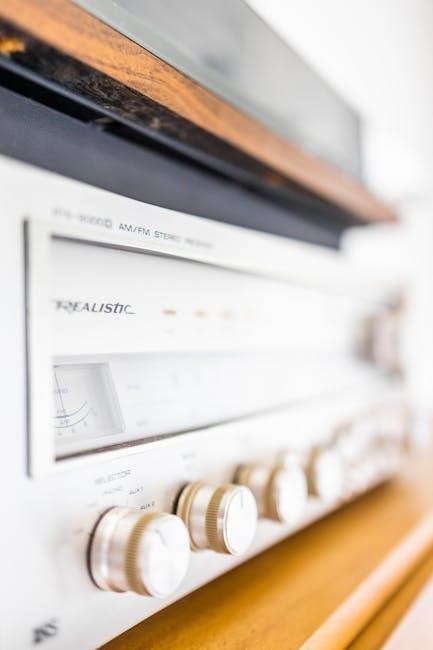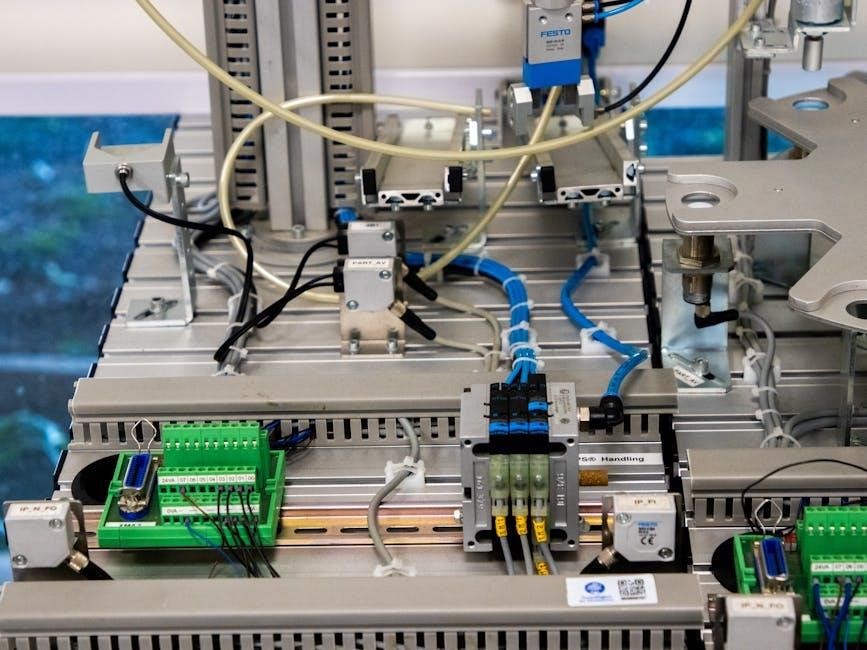Welcome to this comprehensive guide on troubleshooting AMP Research Power Steps․ These popular automotive accessories enhance vehicle accessibility and style, but occasional issues may arise․ This guide provides structured solutions to common problems, ensuring optimal performance and longevity of your power steps․
1․1 Overview of AMP Research Power Steps
AMP Research Power Steps are a popular aftermarket accessory designed to enhance vehicle accessibility and style․ Known for their durability and sleek design, these power-operated running boards automatically deploy when the door opens and retract when closed․ They are particularly favored by truck and SUV owners due to their convenience and functionality․ The system integrates advanced features such as LED lighting for improved visibility and a robust construction to withstand harsh environmental conditions․ Despite their reliability, occasional issues may arise, necessitating proper troubleshooting and maintenance․ This guide provides a comprehensive overview of the AMP Research Power Steps, highlighting their key components and operational principles․ By understanding how these systems work, users can better identify and address potential problems, ensuring optimal performance and longevity of their power steps․
1․2 Importance of Regular Maintenance

Regular maintenance is crucial for ensuring the optimal performance and longevity of AMP Research Power Steps․ Over time, environmental factors such as dirt, salt, and moisture can accumulate and cause mechanical and electrical issues․ Neglecting routine upkeep can lead to noisy operation, sticking components, or even complete system failure․ By incorporating maintenance into your vehicle care routine, you can prevent many common problems before they arise․ This includes cleaning debris from pivot points, lubricating moving parts, and inspecting electrical connections․ Regular checks also help identify potential issues early, saving time and money on repairs․ Proper maintenance not only extends the life of your power steps but also ensures they continue to function safely and reliably․ A well-maintained system enhances both the convenience and aesthetic appeal of your vehicle, making regular upkeep a worthwhile investment․

Common Issues with AMP Research Power Steps

AMP Research Power Steps often face issues like noise during operation, mechanical obstructions, electrical faults, and LED light failures․ These problems frequently stem from environmental factors or system component wear․
2․1 Noise During Operation
Noise during operation is a common issue with AMP Research Power Steps, often caused by the buildup of salt, mud, or debris in the mechanism․ This can lead to grinding or clicking sounds․ Additionally, environmental factors like ice or snow can cause the steps to stick or malfunction, resulting in unusual noises․ If the steps are retracting slowly or irregularly, it may indicate debris or intermittent contact within the system․ Regular cleaning and lubrication of the hinges and pivot points can help prevent these issues․ Applying a lubricant like WD-40 to moving parts ensures smooth operation and reduces noise․ If the noise persists, inspecting the motor and actuator for wear or damage may be necessary․ Ensuring the system is free from obstructions and properly maintained can significantly reduce operational noise and extend the lifespan of your AMP Research Power Steps․
2․2 Mechanical Obstructions
Mechanical obstructions are a frequent cause of malfunctions in AMP Research Power Steps․ Debris such as mud, dirt, salt, or ice can accumulate in the hinges and pivot points, causing the steps to bind or move unevenly․ This buildup can prevent smooth operation and lead to sticking or incomplete deployment․ To address this, start by thoroughly inspecting the mechanism for any visible blockages․ Use a pressure washer or a stiff brush to remove grime and debris from the hinges and pivot points․ Lubricating these areas with a product like WD-40 can restore smooth movement and prevent future issues․ Additionally, check for any physical damage or misalignment in the steps or their mounting points․ If the steps are physically binding against the vehicle’s frame, adjust their position to ensure proper clearance․ Regular cleaning and maintenance are essential to prevent mechanical obstructions and ensure reliable performance of your AMP Research Power Steps․
2․3 Electrical Faults
Electrical faults can disrupt the proper functioning of AMP Research Power Steps, often leading to unexpected malfunctions․ Common issues include loose or corroded connections, blown fuses, or damaged wiring․ Start by inspecting the inline fuse near the battery; if it’s blown, replace it with a 30A blade fuse․ Check the wiring harness for cuts, abrasions, or corrosion, as these can disrupt power supply․ Ensure all electrical connections, especially the white rubber connectors, are secure and free from debris․ Use a multimeter to test for continuity and verify the power supply to the step motor․ If the controller module under the hood feels warm or shows signs of damage, it may indicate an electrical malfunction․ Resetting the system by removing and reinserting the fuse can sometimes resolve software-related issues․ If problems persist, consult the AMP Research troubleshooting guide or contact a professional for advanced diagnostics and repair․
2․4 LED Light Failures
LED light failures on AMP Research Power Steps can indicate underlying electrical or connectivity issues․ If the LED lights are not illuminating, start by checking the electrical connections for corrosion or looseness․ Ensure the fuse related to the power step system is intact and not blown․ Clean any debris or moisture from the connectors, as these can disrupt power flow․ If the issue persists, inspect the wiring harness for damage or wear․ Verify that the controller module is functioning correctly, as it powers the LED lights․ Resetting the system by removing and reinserting the fuse may resolve software-related issues․ If the lights still fail to illuminate, consult the troubleshooting guide for specific steps or contact a professional for assistance․ LED failures, while often minor, can signal broader electrical problems, so addressing them promptly is essential for maintaining system performance․

Troubleshooting Steps
This section provides a structured approach to diagnosing and resolving issues with your AMP Research Power Steps․ Start with visual inspections and cleaning mechanisms to address common malfunctions effectively and ensure smooth operation․
3․1 Visual Inspection
A visual inspection is the first step in diagnosing issues with your AMP Research Power Steps․ Begin by examining the running boards and mechanisms for visible obstructions such as mud, ice, or debris․ Check for any physical damage to the steps, hinges, or pivot points․ Ensure the steps are not binding against the vehicle’s frame or other components․ Look for signs of wear or misalignment in the linkage or actuator arms․ Verify that the LED lights are functioning properly, as their failure can indicate electrical issues․ Inspect the plastic cups holding the bumpers for flattening, which can disrupt smooth operation․ Use this opportunity to assess the overall condition of the power step system․ Addressing visible problems early can prevent more severe malfunctions․ Regular visual checks are essential for maintaining the reliability and performance of your AMP Research Power Steps․

3․2 Cleaning and Lubricating
Cleaning and lubricating are essential for maintaining the smooth operation of your AMP Research Power Steps․ Start by removing dirt, mud, or debris from the hinges, pivot points, and mechanisms using a pressure washer or a hose with a nozzle․ For stubborn buildup, use a soft brush or cloth to gently scrub the affected areas․ After cleaning, apply a lubricant like WD-40 to the hinges and pivot points to prevent binding and ensure smooth movement․ Pay attention to the plastic cups that hold the bumpers, as they may need to be cleaned or replaced if damaged․ Regular cleaning and lubrication can prevent common issues like noise or sticking․ For optimal results, perform this maintenance periodically, especially after exposure to harsh conditions such as salt, snow, or heavy mud․ This proactive approach will extend the lifespan of your power steps and maintain their reliability․
3․3 Checking Electrical Connections
Checking electrical connections is crucial for diagnosing issues with your AMP Research Power Steps․ Start by inspecting the white rubber connectors and ensuring they are properly seated and free from corrosion․ Verify the inline fuse, typically located near the battery, and replace it if necessary․ Examine the wiring harness for any signs of damage, such as cuts, abrasions, or corrosion, which can disrupt power supply․ Use a multimeter to test for continuity and ensure the power supply to the step motor is stable․ Clean any corroded connections with a wire brush and apply a protective spray․ Also, check the door trigger wires connected to the door ajar circuit, as loose or damaged connections can prevent proper operation․ If issues persist, consult the AMP Research troubleshooting guide for specific diagrams and instructions tailored to your model․
3․4 Diagnosing the Controller
Diagnosing the controller is essential for resolving complex electrical issues with your AMP Research Power Steps․ Locate the controller, typically under the hood, and inspect for visible damage or water exposure․ Ensure it is not excessively warm, as overheating can indicate a malfunction․ If the controller’s software is unresponsive, try resetting it by removing and reinstalling the fuse․ This process can reboot the system and restore functionality․ If the issue persists, check the OBDII module connection, as communication loss can disrupt operation․ Refer to the AMP Research website for model-specific diagrams and troubleshooting guides․ If the controller consistently fails after these steps, it may need replacement․ Always use genuine AMP Research parts to maintain system integrity and performance․ If unsure, consult a professional or authorized dealer for assistance․

3․5 Motor and Actuator Issues
Motor and actuator issues can significantly impair the functionality of your AMP Research Power Steps․ If the motor engages but the steps fail to move, it may indicate a problem with the actuator or motor itself․ Listen for unusual noises, such as ticking or grinding, which can signal worn or damaged components․ Inspect the motor and actuator for visible damage or obstructions that might hinder movement․ Check for debris buildup or corrosion in the mechanism, as these can disrupt operation․ If the steps move erratically or stall, it could point to a failing motor or actuator․ Replace any damaged parts with genuine AMP Research components to ensure proper function․ For complex issues, consult the troubleshooting guide or contact AMP Research support for further assistance․ Addressing these problems promptly will help maintain the reliability and performance of your power steps․

3․6 System Reset
A system reset is a straightforward troubleshooting step for AMP Research Power Steps․ To perform a reset, locate the fuse for the power steps, typically found in the vehicle’s fuse box, and remove it for several minutes․ This action interrupts power to the control module, allowing the system to reboot and clear any temporary software glitches․ If your system uses an OBDII quick plug, disconnecting and reconnecting it can achieve a similar reset․ After restoring power, test the steps to see if the issue is resolved․ If the steps were stuck in the deployed position, they may retract normally after the reset․ However, if the problem persists, further investigation into the controller, wiring, or motor may be necessary․ A system reset is a helpful diagnostic tool but does not replace the need for repairs in cases of underlying mechanical or electrical faults․

Maintenance Tips
Regular cleaning, lubrication, and inspections are essential to maintain your AMP Research Power Steps․ Protect them from environmental factors and ensure all components function smoothly for long-term reliability and performance․

4․1 Routine Cleaning
Routine cleaning is essential to ensure the smooth operation of your AMP Research Power Steps․ Start by using a pressure washer or hose to remove dirt, mud, and debris from the mechanisms․ For stubborn buildup, use a soft brush or cloth to gently scrub away grime․ Pay special attention to hinges and pivot points, as these areas are prone to collecting dirt and salt․ After cleaning, apply a lubricant like WD-40 to these components to prevent rust and ensure smooth movement․ Additionally, inspect and clean the plastic cups that cushion the step arms, as worn or flattened cups can cause improper alignment․ Regularly cleaning your power steps not only improves functionality but also prevents potential issues like mechanical binding or electrical malfunctions․ By incorporating cleaning into your maintenance routine, you can extend the lifespan of your AMP Research Power Steps and maintain their reliability․
4․2 Lubrication Best Practices
Proper lubrication is crucial for maintaining the smooth operation of your AMP Research Power Steps․ Start by applying a high-quality silicone-based lubricant to all moving parts, including hinges, pivot points, and linkages․ Avoid using heavy oils or greases, as they can attract dirt and debris, leading to premature wear․ Instead, opt for a spray lubricant that penetrates deeply and dries quickly, leaving a protective barrier against rust and corrosion․ Lubricate these components every 3 to 6 months or after exposure to harsh conditions like salt, mud, or heavy rain․ Before applying lubricant, ensure the area is clean and free of debris to prevent trapping contaminants․ Regular lubrication will help maintain the longevity of your power steps and ensure they operate quietly and efficiently․ This simple maintenance step can prevent costly repairs and keep your steps functioning like new for years to come․
4․3 Protecting from Environmental Factors
Protecting your AMP Research Power Steps from environmental factors is essential to ensure their longevity and optimal performance․ Regularly clean the steps, especially after exposure to salt, mud, or debris, using a pressure washer or a mild detergent to prevent grime buildup․ Apply a rust-inhibiting coating or silicone-based spray to metal components to shield them from corrosion caused by salt and moisture․ For added protection, consider using waterproof covers when the vehicle is not in use to keep the steps dry and clean․ Parking in a garage or sheltered area can also minimize exposure to harsh weather conditions․ Seasonal maintenance is crucial—apply a durable protective coating before winter and clean off salt residue afterward; By combining regular cleaning, proper lubrication, and protective measures, you can effectively safeguard your power steps from environmental damage and ensure they continue to function smoothly․
4․4 Regular Inspections
Regular inspections are vital for maintaining the functionality and longevity of your AMP Research Power Steps․ Start by visually examining the steps, hinges, and pivot points for signs of wear, misalignment, or damage․ Check the condition of the plastic cups that cushion the step arms, ensuring they are not flattened or cracked․ Inspect the wiring harness for any signs of damage, such as cuts, abrasions, or corrosion, which could disrupt power supply․ Verify that all electrical connections, including the white rubber connectors, are secure and free from corrosion․ Lubricate the hinges and pivot points periodically to prevent binding and ensure smooth operation․ Additionally, test the LED lights to ensure they are functioning properly, as their failure can indicate broader electrical issues․ By incorporating regular inspections into your maintenance routine, you can identify and address potential problems early, preventing unexpected malfunctions and extending the life of your power steps․
By following this guide, you can effectively troubleshoot and maintain your AMP Research Power Steps, ensuring reliability and longevity․ Regular inspections and timely repairs will keep your steps functioning smoothly․
5․1 Final Thoughts
5․2 When to Seek Professional Help
While many issues with AMP Research Power Steps can be resolved through DIY troubleshooting, there are situations where professional assistance is necessary․ If you encounter complex electrical faults, persistent motor or actuator problems, or significant damage to components, it’s best to seek help from a qualified technician․ Additionally, if you’re unsure about diagnosing or repairing advanced systems like the control module or wiring harness, a professional can provide specialized tools and expertise․ Attempting repairs without proper knowledge may lead to further damage or safety risks․ Always consult an authorized AMP Research dealer or a skilled automotive technician for intricate issues․ They can ensure proper repairs and maintain your system’s performance and reliability․ Don’t hesitate to contact AMP Research support for guidance on finding a certified professional in your area․
